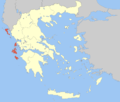Lefkada
Lefkada (Greek: Λευκάδα, Lefkáda, [lefˈkaða]), also known as Lefkas or Leukas[2] (Ancient Greek and Katharevousa: Λευκάς, Leukás, modern pronunciation Lefkás) and Leucadia, is a Greek island in the Ionian Sea on the west coast of Greece, connected to the mainland by a long causeway and floating bridge. The principal town of the island and seat of the municipality is Lefkada.[3] It is situated on the northern part of the island, approximately 1 hour by automobile away from Aktion National Airport. The island is part of the regional unit of Lefkada.
Lefkada Λευκάδα | |
|---|---|
View of Lefkada (city) | |
 Lefkada Location within the region 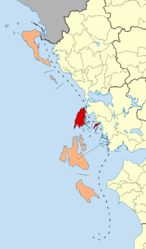 | |
| Coordinates: 38°43′N 20°39′E | |
| Country | Greece |
| Administrative region | Ionian Islands |
| Regional unit | Lefkada |
| Area | |
| • Municipality | 333.6 km2 (128.8 sq mi) |
| Population (2011)[1] | |
| • Municipality | 22,652 |
| • Municipality density | 68/km2 (180/sq mi) |
| Time zone | UTC+2 (EET) |
| • Summer (DST) | UTC+3 (EEST) |
Geography
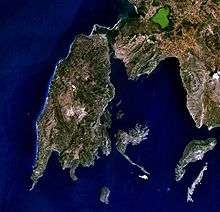
Lefkada measures 35 kilometres (22 miles) from north to south, and 15 kilometres (9 miles) from east to west. The area of the island is about 302 square kilometres (117 sq mi), the area of the municipality (including the islands Kalamos, Kastos and several smaller islets) is 333.58 km2 (128.80 sq mi).[4] Its highest point is the mountain Stavrota, 1,158 metres (3,799 feet) above sea level,[5] situated in the middle of the island. The east coast section of the island has small resorts of Lygia, Nikiana and Perigiali, all north of Nidri, the largest resort on the island. It is set in a sheltered location with views across to Skorpios (formerly owned by Aristotle Onassis), Meganisi and other small islands, as well as the Greek mainland. The main coastal road from Lefkada to Vasiliki runs through the village, although a bypass has now been completed which skirts the village to the west. There are regular car ferries to Kefalonia, Ithaca and Meganissi.
20 kilometres (12 miles) south of Nidri is the resort of Vasiliki, a windsurfing center. There are ferries to Kefalonia and Ithaca from Vasiliki. South of Vasiliki is Cape Lefkada, where the Greek female poet Sappho allegedly leapt to her death from the 30 m high cliffs.
The famous beach of Porto Katsiki is located on Lefkada's west coast. Lefkada was attached to mainland Greece (see below about Homer's Ithaca being Lefkada). The Corinthians dug a trench in the 7th century BC on its isthmus.[6]
Climate
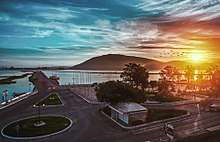
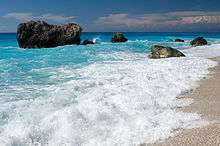
The island has a typical Mediterranean climate: hot summers and cool winters, especially in the mountains.
History
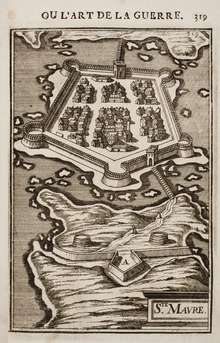
Antiquity
The myth about Sappho's suicide at Cape Lefkada is related to other myths linking the island to the ancient Greek goddess of love, Aphrodite, and to Odysseus, the hero of Homer's Odyssey. The German archaeologist Wilhelm Dörpfeld, having performed excavations at various locations of Lefkada, was able to obtain funding to do work on the island by suggesting that Lefkada was Homer's Ithaca, and the palace of Odysseus was located west of Nydri on the south coast of Lefkada. There have been suggestions by local tourism officials that several passages in the Odyssey point to Lefkada as a possible model for Homeric Ithaca. The most notable of these passages pushed by the local tourism board describes Ithaca as an island reachable on foot, which was the case for Lefkada since it is not really an island, that it was connected to the mainland by a narrow causeway. According to Strabo, the coast of Acarnania was called Leucas in earlier times. The ancient sources call Leucas a Corinthian colony, perhaps with a Corcyraen participation.[7] During the Peloponnesian War Leucas joined the Spartan Confederation.[8]
Middle Ages
Lefkada was part of the Despotate of Epirus until 1295 when it passed from Despot Nikephoros I to his son-in-law John Orsini.[9] The Castle of Santa Maura, which eventually gave its name to the island, was first built in the beginning of the 14th century; the possession of the castle was key to holding the island.[9] The Orsini family lost Lefkada in 1331, to the Angevins.[9] In 1343, Walter of Brienne granted Lefkada and the Santa Maura castle to Venetian Graziano Giorgio.[10] Between 1343 and 1348, Serbian ruler Stefan Dušan invaded Albania, Epirus and Thessaly, conquering all except for Vonitsa and Santa Maura.[10] In 1362, Leonardo I Tocco seized Lefkada and Vonitsa.[10] In 1479, the Ottomans took Lefkada, and rebuilt the castle on a large scale (the core of the castle being Ottoman).[9]
Early modern period
The Venetians briefly held Lefkada between 1500 and 1503, during the Ottoman-Venetian War, after which it was returned to Ottoman rule by peace treaty.[9] Ottoman rule was interrupted by Venice in 1684,[9] with the Ottomans surrendering it after a 16-day siege, and was thus again part of the Ionian Islands under Venetian rule.[11]
The Ottomans called it Ayamavra, from Greek Agia Maura (Αγία Μαύρα meaning "Santa Maura"), and ruled it between 1479–1502, 1504–1684 and 1715-1716.[12] The Venetians extensively modified the castle in the early 18th century, and the British also made some modification in the 19th century.[9]
In 1800, the Septinsular Republic was established, a Russian protectorate under de jure Ottoman suzerainty. The Russian Empire employed troops recruited from fugitive klephts and armatoloi in the Ionian Islands, particularly of Lefkada. Among these were captains Anastasios Tselios and Apostolos Levendakis, the latter who already in 1802 offered to raise a company of 60 fighters on Lefkada to support the Russians.[13]
In 1815, Great Britain set up the United States of the Ionian Islands as a protectorate which lasted until 1864, when the islands were ceded to Greece. One of the seven island states was Lefkada.
Lafcadio Hearn Historical Center
The first museum in Europe for Lafcadio Hearn, who was born on the island and is named after it, was inaugurated in Lefkada on July 4, 2014, as Lafcadio Hearn Historical Center. It contains early editions, rare books and Japanese collectibles. The visitors, through photos, texts and exhibits, can wander in the significant events of Lafcadio Hearn's life, but also in the civilizations of Europe, America and Japan of late 18th and early 19th centuries through the open mind of his lectures, writings and tales. The municipalities of Kumamoto, Matsue, Shinjuku, Yaizu, Toyama University, Koizumi family and other people from Japan and Greece contributed to the establishment of Lafcadio Hearn Historical Center.
Municipality
The present municipality Lefkada was formed at the 2011 local government reform by the merger of the following 7 former municipalities, that became municipal units:[3]
The municipality covers the island Lefkada and the smaller islands Kastos and Kalamos.
Notable people
(in chronological order)
- Marcos Christino Fioravanti (1775–1862), co-founder of Santo Antônio da Patrulha in Brazil
- Frederick Temple (1821–1902), Archbishop of Canterbury
- Aristotelis Valaoritis (1824–1879), poet and politician
- Lafcadio Hearn (1850–1904), Greco-Irish orientalist and writer, named after the island
- Petros Soumilas (1861–19??), Greek Army officer who reached the rank of lieutenant general.
- Dimitrios Golemis (1874–1941), athlete
- Grigorios Karydis (1912–1968), musician, opera composer and professor of philharmonic orchestra
- Aggelos Sikelianos (1884–1951), poet and playwright
- Tzavalas Karousos or Karoussos (1904–1969), actor
- Aristotle Onassis, (1906–1975), Greek shipping tycoon
- Panos Rontoyannis (1911–1996), philologist and historian
- Theodoros Stamos (1922–1997), Greek-American painter
- Apostolos Kaklamanis (1936), politician
- Evaggelos Vlassopoulos (1935–2002), politician
- George Ktenas (1938-2004), politician
- Agnes Baltsa (1944), opera singer
- Spyros Vrettos (1960), poet
- John Zavitsanos (1962-), American trial lawyer
- Spiros Marangos (1967-), footballer
- Marina Lambrini Diamandis (1985-), singer and songwriter
- Gerasimos Caclamanes (1940-2003) mathematician and author
Gallery
- Traditional street of Lefkada (city)
- Panagia ton Xenon, Lefkada city
- Porto Katsiki beach
 Kalamos village
Kalamos village- Traditional dress
See also
Notes
- "Απογραφή Πληθυσμού - Κατοικιών 2011. ΜΟΝΙΜΟΣ Πληθυσμός" (in Greek). Hellenic Statistical Authority.
- Potts, Jim (2010). The Ionian Islands and Epirus: A Cultural History. Oxford and New York: Oxford University Press. p. ix. ISBN 978-0-19-975416-8. Retrieved 16 June 2011.
- Kallikratis law Greece Ministry of Interior (in Greek)
- "Population & housing census 2001 (incl. area and average elevation)" (PDF) (in Greek). National Statistical Service of Greece. Archived from the original (PDF) on 2015-09-21.
- Oreivatein.com
- Strabo 10.452
- Colony and mother city in ancient Greece By A. J. Graham Page 132 ISBN 0-7190-0059-9
- The Peloponnesian War: Athens, Sparta and the struggle for Greece By Nigel Bagnall Page 17 ISBN 0-312-34215-2
- Brooks 2013, p. 102.
- Allan Brooks (1 May 2013). Castles of Northwest Greece: From the early Byzantine Period to the eve of the First World War. Aetos Press. pp. 287–. ISBN 978-0-9575846-0-0.
- Brooks 2013, p. 103.
- "Google Drive Görüntüleyici". Docs.google.com. Retrieved 2013-03-26.
- Nicholas Charles Pappas (1982). Greeks in Russian military service in the late eighteen and early nineteenth centuries. Stanford University.
These troops were recruited from among the fugitive klephtes and armatoloi residing on the Ionian Islands, particularly Lefkas. Among these men were the Captains Anastasios Tselios and Apostolos Levendakls. Tselios was a member of a prominent family of armatoloi from Xeromeros in southwestern Greece. As early as 1802, he had offered his services to the Septinsular Republic, proposing to raise and command a company of sixty men on Lefkas. ... In April 1806, this kapitanios and his men were among a number of refugee armatoloi on Lefkas. including the kapitanaioi Skylodemos, Stratos, Giannes Kolovelones, Konstantes Poules, Giorgakes — — 72 Varnakiotes and others. By June ...
Sources
- Fine, John Van Antwerp Jr. (1994) [1987]. The Late Medieval Balkans: A Critical Survey from the Late Twelfth Century to the Ottoman Conquest. Ann Arbor, Michigan: University of Michigan Press.CS1 maint: ref=harv (link)
- Zečević, Nada (2014). The Tocco of the Greek Realm: Nobility, Power and Migration in Latin Greece (14th-15th centuries). Belgrade: Makart.CS1 maint: ref=harv (link)
External links
| Wikimedia Commons has media related to Lefkada. |
- Lefkada Prefecture
- Travel Guide to Lefkada
- The official page of Greek National Tourism Organization
- Map of Homer's Ithaka (Lefkada), Same and Asteris according to Wilhelm Dörpfeld. Digital library of Heidelberg University.
- Photo of Dörpfeld's excavation site at Lefkada near Nydri, early in the 20th century. Digital library of Heidelberg University.
